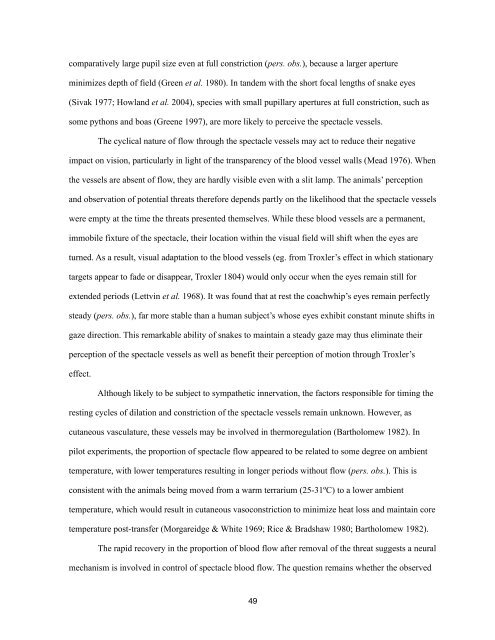Chapter 1, The Reptilian Spectacle - UWSpace - University of ...
Chapter 1, The Reptilian Spectacle - UWSpace - University of ...
Chapter 1, The Reptilian Spectacle - UWSpace - University of ...
You also want an ePaper? Increase the reach of your titles
YUMPU automatically turns print PDFs into web optimized ePapers that Google loves.
comparatively large pupil size even at full constriction (pers. obs.), because a larger aperture<br />
minimizes depth <strong>of</strong> field (Green et al. 1980). In tandem with the short focal lengths <strong>of</strong> snake eyes<br />
(Sivak 1977; Howland et al. 2004), species with small pupillary apertures at full constriction, such as<br />
some pythons and boas (Greene 1997), are more likely to perceive the spectacle vessels.<br />
<strong>The</strong> cyclical nature <strong>of</strong> flow through the spectacle vessels may act to reduce their negative<br />
impact on vision, particularly in light <strong>of</strong> the transparency <strong>of</strong> the blood vessel walls (Mead 1976). When<br />
the vessels are absent <strong>of</strong> flow, they are hardly visible even with a slit lamp. <strong>The</strong> animals’ perception<br />
and observation <strong>of</strong> potential threats therefore depends partly on the likelihood that the spectacle vessels<br />
were empty at the time the threats presented themselves. While these blood vessels are a permanent,<br />
immobile fixture <strong>of</strong> the spectacle, their location within the visual field will shift when the eyes are<br />
turned. As a result, visual adaptation to the blood vessels (eg. from Troxler’s effect in which stationary<br />
targets appear to fade or disappear, Troxler 1804) would only occur when the eyes remain still for<br />
extended periods (Lettvin et al. 1968). It was found that at rest the coachwhip’s eyes remain perfectly<br />
steady (pers. obs.), far more stable than a human subject’s whose eyes exhibit constant minute shifts in<br />
gaze direction. This remarkable ability <strong>of</strong> snakes to maintain a steady gaze may thus eliminate their<br />
perception <strong>of</strong> the spectacle vessels as well as benefit their perception <strong>of</strong> motion through Troxler’s<br />
effect.<br />
Although likely to be subject to sympathetic innervation, the factors responsible for timing the<br />
resting cycles <strong>of</strong> dilation and constriction <strong>of</strong> the spectacle vessels remain unknown. However, as<br />
cutaneous vasculature, these vessels may be involved in thermoregulation (Bartholomew 1982). In<br />
pilot experiments, the proportion <strong>of</strong> spectacle flow appeared to be related to some degree on ambient<br />
temperature, with lower temperatures resulting in longer periods without flow (pers. obs.). This is<br />
consistent with the animals being moved from a warm terrarium (25-31ºC) to a lower ambient<br />
temperature, which would result in cutaneous vasoconstriction to minimize heat loss and maintain core<br />
temperature post-transfer (Morgareidge & White 1969; Rice & Bradshaw 1980; Bartholomew 1982).<br />
<strong>The</strong> rapid recovery in the proportion <strong>of</strong> blood flow after removal <strong>of</strong> the threat suggests a neural<br />
mechanism is involved in control <strong>of</strong> spectacle blood flow. <strong>The</strong> question remains whether the observed<br />
49
















